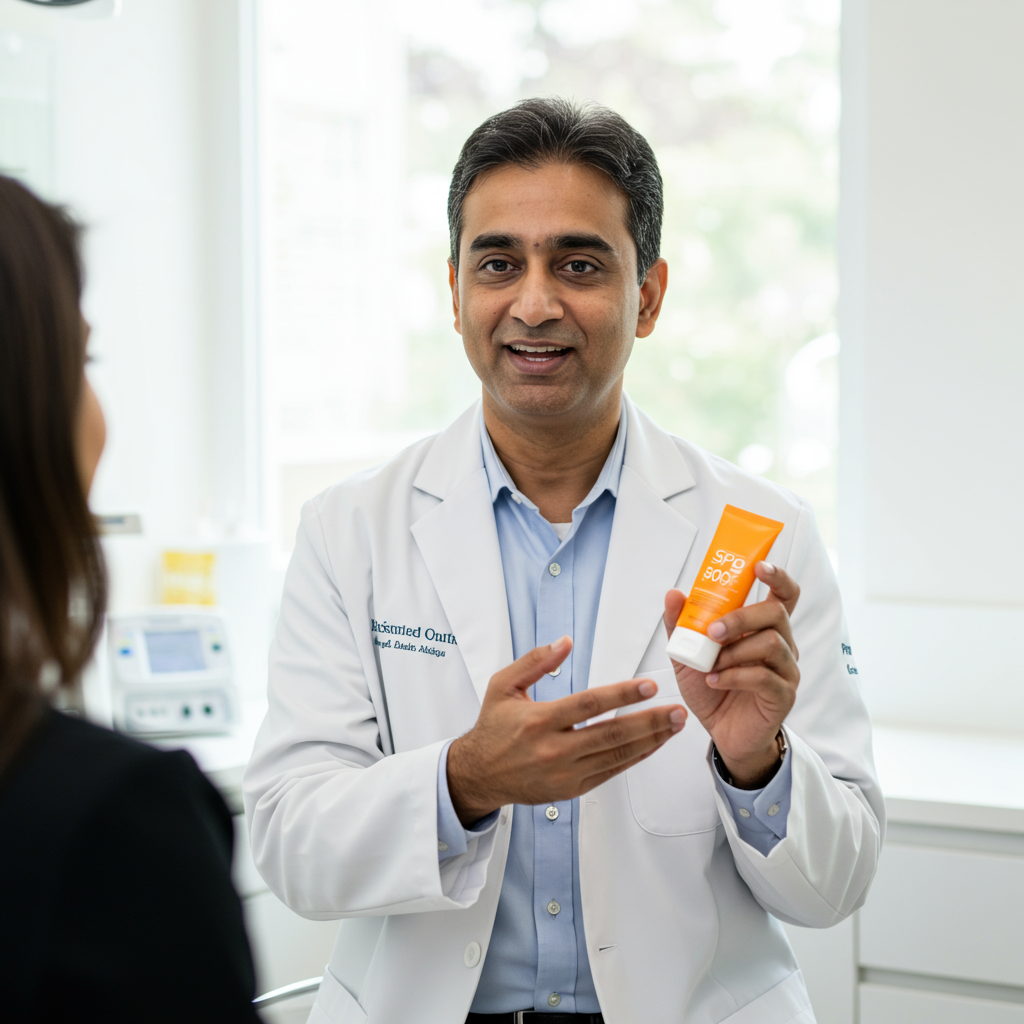Choosing the right sunscreen can feel overwhelming. With rows of bottles boasting various Sun protection Factor (SPF) numbers, how do you know which offers the best defense against harmful UV rays? Protecting your skin from sun damage isn’t just about preventing painful sunburns; it’s a critical step in reducing your risk of skin cancer and slowing down premature aging. But is a higher number always better? And what do skin experts actually use and recommend? We’ve synthesized insights from leading dermatologists to cut through the confusion and provide a clear, actionable guide to selecting the ideal SPF for your needs.
Understanding SPF: More Than Just a Number
SPF, or Sun Protection Factor, is a measure of how much solar energy is needed to cause a sunburn on skin protected with sunscreen compared to unprotected skin. The US Food and Drug Administration (FDA) defines it this way. It primarily indicates protection against UVB rays, which are the main cause of sunburn. Logic might suggest that doubling the SPF doubles the protection. However, the reality is slightly more nuanced.
Does a Higher SPF Offer Significantly More Protection?
Yes, but perhaps not in the way you might think. While SPF 30 theoretically blocks about 96.7% of UVB rays and SPF 50 blocks around 98%, the difference seems small in a lab setting. Board-certified dermatologist Dr. Steven Daveluy notes this minimal gap in tested scenarios. However, dermatologists emphasize that real-world use paints a different picture.
Studies reveal that most people apply only 25% to 50% of the recommended amount of sunscreen. This significant under-application means the stated SPF on the bottle isn’t what your skin is actually receiving. Due to this common mistake, opting for a higher SPF, like 50 or 60, provides a crucial buffer. Even when applied too thinly, a higher SPF product may still deliver protection equivalent to or exceeding a lower SPF applied inadequately. Experts like Dr. Daveluy and Dr. Glenn Kolansky from Hackensack Meridian Jersey Shore University Medical Center suggest SPF 50 or 60 is often a better practical choice.
The Dermatologist-Recommended Minimum SPF
The consensus among dermatologists and organizations like the American Academy of Dermatology Association (AAD) is clear: use a sunscreen with an SPF of 30 or higher. Dr. Daveluy states that SPF 30 is perfectly sufficient if you apply the correct amount. However, recognizing that consistent, generous application is rare, many experts lean towards recommending 50 or 60 to ensure adequate protection in practice. So, while 30 is the absolute minimum, a higher number offers a safety net against typical under-application.
Beyond the SPF Number: Essential Sunscreen Features
Focusing solely on the SPF number misses other equally vital aspects of effective sun protection. Dermatologists consistently highlight two non-negotiable features:
Broad-Spectrum Protection
Sunlight contains two types of ultraviolet (UV) radiation that damage skin: UVA and UVB. UVB rays cause sunburns, while UVA rays penetrate deeper, contributing to premature aging (wrinkles, age spots) and also playing a role in skin cancer development. A sunscreen labeled “broad spectrum” protects against both UVA and UVB rays. Always look for this designation on the label.
Water Resistance
No sunscreen is truly “waterproof.” They are rated as “water resistant” for either 40 or 80 minutes. This rating indicates how long the SPF remains effective while swimming or sweating. Even with a water-resistant formula, you must reapply after this time or immediately after towel drying. Regular sunscreens lose effectiveness much faster when exposed to water or sweat.
mineral vs. Chemical Sunscreens: Making the Right Choice
Sunscreen formulations generally fall into two camps: mineral (physical) and chemical. Understanding how they work can help you choose based on your skin type and preferences.
How They Work
Mineral sunblocks typically contain zinc oxide and/or titanium dioxide. These active ingredients sit on the skin’s surface and act as a physical barrier, reflecting UV rays away. Chemical sunscreens use ingredients like avobenzone, octocrylene, or homosalate. These compounds absorb UV radiation as it enters the skin and convert it into heat, which the skin then releases.
Dermatologist Preferences
Dermatologist Dr. Jason Solway personally recommends mineral-only sunblocks. He notes they provide broad-spectrum protection with a lower risk of allergic reactions, making them excellent for sensitive skin. Dr. Viktoryia Kazlouskaya and Dr. Anna Chacon also often advise mineral options, citing “better-for-you ingredients,” less irritation, and anti-inflammatory properties, especially beneficial for sensitive or acne-prone skin.
While a 2020 FDA study found that some chemical sunscreen compounds can be absorbed into the bloodstream, the FDA still considers them safe for use. Dr. Solway emphasizes this point, but his personal preference leans towards mineral due to the known safety and low irritation profile of zinc oxide and titanium dioxide.
Pros and Cons
Mineral: Generally less irritating, good for sensitive or acne-prone skin, environmentally friendlier (less harmful to coral reefs), sits on top of skin. Can sometimes leave a white cast, especially on darker skin tones, though formulations are improving.
Chemical: Often rub in more easily, less likely to leave a white cast, typically lighter textures. May cause irritation or allergic reactions in some individuals.
Ultimately, experts agree that the most effective sunscreen is one you will actually use consistently. If a chemical sunscreen is the only formula you find wearable, its protection is far better than using nothing at all.
Does Skin Tone Matter When Choosing SPF?
Everyone, regardless of skin tone, needs sun protection. While individuals with darker skin tones have more melanin, which provides some natural defense against UV rays, their risk of sun damage and skin cancer is not zero. In fact, studies suggest people of color may face a higher chance of delayed skin cancer diagnoses, making outcomes more dangerous. Dr. Glenn Kolansky points to the tragic case of Bob Marley, who died from melanoma under his toenail, as a stark reminder that skin cancer can occur anywhere and affect anyone.
Dr. Daveluy stresses that SPF 30 is the minimum for everyone. However, those with very fair skin may benefit more noticeably from higher SPF numbers, especially if under-applying, because the visible consequences of sun exposure (like sunburn) appear more easily on lighter skin. For individuals with darker skin tones, tinted mineral sunscreens are often recommended to minimize the white cast that some mineral formulas can leave.
Getting Application Right: How Much and How Often
Proper application is paramount, even more so than chasing the highest SPF number.
How Much to Apply
The general guideline is to use about one ounce of sunscreen to cover exposed areas like the head, neck, arms, and legs when wearing shorts and a T-shirt. One ounce is roughly the amount needed to fill a standard shot glass. Dr. Daveluy points out that a typical 3-ounce bottle contains only about three such applications, highlighting how quickly you should go through a tube if applying correctly. People with less hair should use a little more on the head.
How Often to Reapply
Experts recommend reapplying sunscreen every two hours, regardless of the SPF number. This is crucial because sunscreen degrades over time and becomes less effective. You also need to reapply immediately after swimming or sweating, even if the product is labeled water-resistant, as mentioned earlier.
Essential Sun Protection Beyond the Bottle
Sunscreen is a vital tool, but it’s just one part of comprehensive sun safety. Dermatologists advise combining sunscreen use with other protective measures:
Seek Shade: Stay in the shade, especially during peak sun hours (typically 10 a.m. to 4 p.m.).
Wear Protective Clothing: Opt for long sleeves, pants, and fabrics with a UPF (Ultraviolet Protection Factor) rating.
Don a Hat: A wide-brimmed hat protects your face, neck, and ears.
Wear Sunglasses: Choose sunglasses that block 99% to 100% of both UVA and UVB rays to protect your eyes and the delicate skin around them.
Consider Daily Use: Sun damage can occur even on cloudy days or through windows. Using a daily moisturizer with SPF or incorporating sunscreen into your morning routine year-round, even indoors or while driving, can help prevent cumulative damage.
Finding the Right Sunscreen for Your Skin Type
With many formulations available, finding a sunscreen you like and will use daily can involve some trial and error. Consider your skin type when choosing:
Sensitive/Acne-Prone Skin: Mineral sunscreens (zinc oxide, titanium dioxide) are often best. Look for oil-free, fragrance-free, and hypoallergenic options. Lightweight or gel textures can also be less likely to clog pores.
Oily Skin: Seek lightweight, oil-free, water-based, or mineral formulas that won’t add shine or feel heavy.
Dry Skin: Look for sunscreens with moisturizing ingredients like hyaluronic acid, ceramides, or shea butter to provide hydration and prevent a chalky finish.
Rosacea or Redness: Tinted mineral sunscreens can help neutralize redness while providing physical sun protection, which is excellent for heat-sensitive conditions like rosacea.
Many dermatologists have their favorite formulations, often looking for elegant textures that blend well without a white cast or greasy feel. Some even layer different products, like an antioxidant serum followed by a tinted SPF moisturizer, as part of a comprehensive morning routine.
Sunscreen Safety: Addressing Misinformation
Despite decades of proven safety and effectiveness, you might encounter reports or individuals claiming sunscreens are unsafe. Dermatologists like Dr. Daveluy call this a “red flag.” Sunscreen ingredients undergo rigorous testing and approval processes. The biggest risk related to sunscreen isn’t using it, but not* using it and leaving your skin vulnerable to damaging UV radiation. Trust credible sources like dermatologists and health organizations over unsubstantiated claims.
Checking Your Skin Regularly
Beyond daily sun protection, a crucial part of skin health involves regular self-examinations. Check your skin head-to-toe once or twice a year, looking for any new spots or changes in existing moles (size, shape, color, texture, bleeding). Ask a partner or family member to check hard-to-see areas like your back. Early detection of skin cancer is vital for successful treatment. If you notice anything suspicious, see a dermatologist immediately.
Frequently Asked Questions
What is the absolute minimum SPF recommended by dermatologists?
Dermatologists and organizations like the American Academy of Dermatology recommend a minimum SPF of 30 for everyone. This level blocks approximately 96.7% of UVB rays. While this is the baseline, many experts suggest SPF 50 or higher is more practical because most people do not apply the recommended amount of sunscreen needed to achieve the full SPF protection listed on the bottle.
Which type of sunscreen is better for sensitive skin or the environment?
Mineral sunscreens, containing active ingredients like zinc oxide and titanium dioxide, are generally considered better for sensitive skin because they sit on the skin’s surface and are less likely to cause irritation compared to chemical sunscreens. Mineral sunscreens are also often favored for being safer for marine environments, specifically coral reefs, as chemical filters can contribute to bleaching.
How much sunscreen should I use and how often should I reapply it for effective protection?
You should use about one ounce (a shot glass full) to cover your exposed body areas. Most standard 3-ounce sunscreen tubes contain only enough for about three full body applications. Reapplication is crucial: apply sunscreen every two hours, especially when spending time outdoors. Reapply immediately after swimming or sweating, even if the product is labeled as water-resistant (which typically lasts 40 or 80 minutes).
Conclusion
Navigating sunscreen options doesn’t have to be complicated. Start by choosing a broad-spectrum, water-resistant formula with at least SPF 30. For a practical safeguard against under-application, consider SPF 50 or higher, as many dermatologists recommend. Mineral sunscreens are often preferred for sensitive skin and environmental reasons, but the best sunscreen is ultimately the one you are willing to use consistently and generously. Remember to apply enough, reapply often, and combine sunscreen with other protective measures like hats, clothing, and shade for the most comprehensive defense against sun damage. Prioritizing sun safety is an investment in your skin’s health and appearance for years to come.



